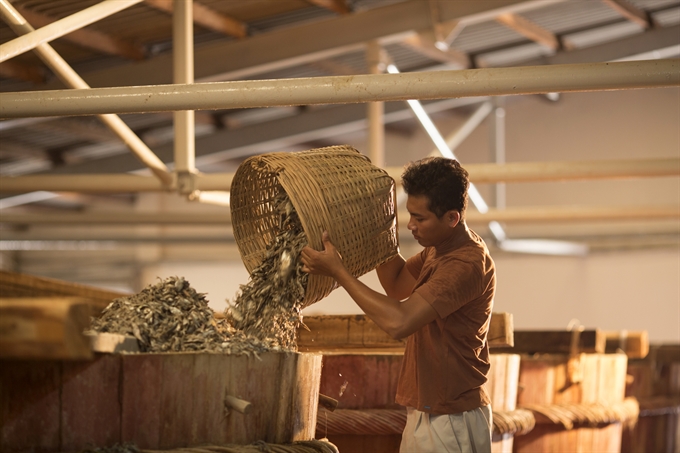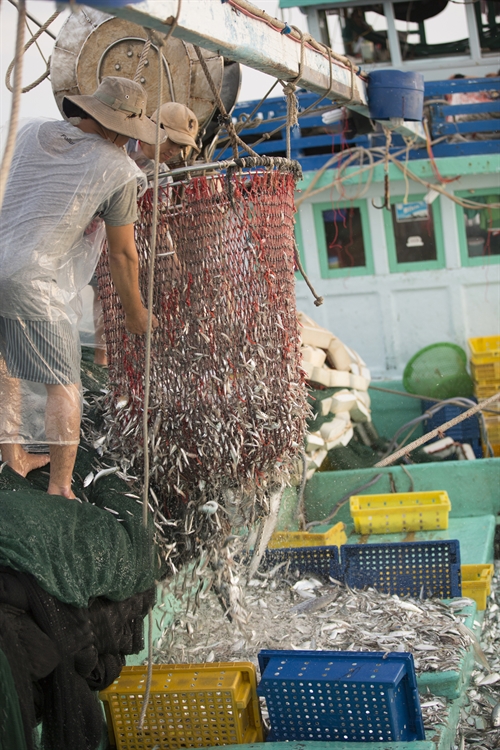 Economy
Economy

" />The fish sauce market is witnessing increasingly fierce competition between many famous brand names that use both industrial and traditional methods like Unilever, Masan Consumer, Phú Quốc, and Phan Thiết.
 |
| Masan’s giant cellar in Phú Quốc Island with hundreds of barrels that is now being made even bigger. VNSPhoto |
HCM CITY – The fish sauce market is witnessing increasingly fierce competition between many famous brand names that use both industrial and traditional methods like Unilever, Masan Consumer, Phú Quốc, and Phan Thiết.
Seasoning is an essential item on a normal Vietnamese family’s dining table, and with demand for it increasing by the day, the industry is growing at an 25-32 per cent a year, according to Nielsen Vietnam.
Among seasonings, fish sauce is considered to have the greatest potential with consumption increasing year after year: 15,434 tonnes in 2005, 75,000 tonnes in 2016 and an expected 98,770 tonnes in 2022.
According to a study by Kantar World panel, 95 per cent of Vietnamese families use fish sauce in their meals and per capita consumption is around 4 litres a year.
Not surprisingly, more and more players have been entering the market.
The competition first intensified when two major brands, Unilever’s Phú Quốc-Knorr and Masan Consumer’s Chinsu, made an entry.
Until then most of the sauces in the market were made in the traditional method and on a small scale.
In 2002 Knorr, a German brand owned by the Anglo-Dutch company Unilever, built a bottling plant on Phú Quốc Island and has since been selling Phú Quốc fish sauce made by local producers and bottled on the island under its own Knorr brand.
The brand’s entry into the market was backed by a marketing campaign with slick television advertisements inviting Vietnamese consumers to "taste the legend."
Unilever was the pioneer in making fish sauce in an industrial production line.
In 2007 Masan Consumer began to sell bottled fish sauce products, soon overtaking Knorr Phú Quốc to reach the No.1 position, and the battle of the fish sauces began in earnest.
Masan built a series of large modern fish sauce plants in Bình Dương and Nghệ An and a cellar for giant wooden barrels containing fermenting anchovies.
It has one of the largest fish sauce production plants on Phú Quốc Island and a giant cellar with hundreds of barrels that is now being made even bigger.
Masasn’s Chinsu and Nam Ngư fish sauces, made on an industrial scale, have rapidly become popular and now account for a nearly 70 per cent market share, also thanks to the company’s big advertising budgets and low prices.
Masan has been followed into the market by many other brands also producing industrially.
In 2009 the Ngọc Nghĩa Group, a company that manufactured packaging for food products, decided to enter the fish sauce industry by buying a stake in the Hồng Phú Food Joint Stock Company and beginning to produce the Kabin and Thái Long brands of sauce.
Not wanting to be left out, noodles and vermicelli giant Acecook entered the market in early 2010 with its Đệ Nhất brand of fish sauce.
The rapid development of industrially produced fish sauces was mostly at the expense of traditionally made products.
According to Euromonitor data, Việt Nam’s fish sauce market was worth VNĐ11.3 trillion (US$502.22 million) in 2015, of which industrial production accounted for 76 per cent.
Many of the traditional producers have reverted to selling their pure fish sauce to industrial producers, who then make and sell products under their own brands.
Lê Cẩm Thủy, deputy director of Cẩm Vân Fish Sauce based in Nha Trang, said the reason the fish sauce market is enticing to investors is the high potential profitability.
“If produced industrially, one litre of pure fish sauce can be made into several litres with an aromatic flavour that consumers will like.”
Yet, not all entrants have actually managed invested to make profits.
Ngọc Nghĩa Company, for instance, has spent considerably on marketing to promote its products and has a 3 per cent share of the market. But it also has accumulated losses of nearly VNĐ800 billion ($35.55 million).
In spite of having a massive distribution network and a famous brand name, Acecook was unable to sustain its fish sauce business, and in 2013 had to sell Đệ Nhất to Nam Phương Việt Nam Company, which renamed it Barona.
Difference
The question is, why have industrially produced fish sauces taken over from traditional ones though the latter has been successful for centuries?
Many analysts attribute this to consumers’changing tastes.
“To answer this question in detail, however, we must know what is the industrial fish sauce and what is traditional fish sauce.”
Many people think traditional fish sauce or fish sauce is made using only “fresh fish (mainly anchovy) mixed with salt and put in a traditional wooden barrel”, while its industrial cousin has additives.
But Phạm Ngọc Dũng, former chairman of the HCM City Fish Sauce Producers Club, who has 38 years’experience in the industry, said there are no pure fish sauces sold in the market now though many companies claim so.
“Firstly, the price of pure fish sauce is so high that not many consumers can afford them: one tonne of fish can give a maximum of 200 litres of pure fish sauce.”
Thus, the price of pure fish sauce is five to seven times higher than one processed with additives, and the income of most consumers is still very modest, he said.
“Secondly, most fish sauce firms now, including Phú Quốc, Phan Thiết and Nha Trang, have to use additives to make their products palatable since pure fish sauce is often very rough and salty.
“All fish sauces are produced with fish, salt and additives, but some are produced in traditional conditions and others in modern industrial conditions, “he said.
But producers must know what chemicals can be used and how much to ensure not only good taste but also consumers’health, he said.
Nowadays people pay a lot of attention to eating healthily and are focused on food safety, he said.
Bùi Huy Nhích, head of Masan Fish Sauce Laboratory, said, “To make good fish sauce, it is very important to have fresh fish, mainly anchovies, since they often give high acidamin.
“The fish for production at Masan is caught from the sea near the barrel house. To ensure freshness, the fish is salted immediately after being caught.
“Before being put into barrels, fresh anchovies must pass through some rigorous checks for other fish, salinity, freshness and dryness to ensure top quality.
“The salt used for aromatising the fish is also very important. Masan often uses salt from Bà-Rịa-Vũng Tàu Province since it does not have acridity of calcium, bitterness of potassium or hotness of magnesium.”
Invest in technology
It is thanks to such rigorous screening, a taste that is not as salty as pure fish sauce and lower prices than Knorr, Hong Hanh, Hung Thinh and Hanh Phuc that Masan has quickly conquered the market despite entering later than many others.
Le Thi Nga of the company said, "Masan built the cellar for producing pure fish sauce in 2008, and it can contain 448 barrels with a combined capacity of 10,000 tonnes of fish.
"This capacity allows it to supply 15 per cent of the pure fish sauce required for processing Chinsu and Nam Ngu fish sauces sold in the market.
"The remainder is bought from major fish sauce production establishments nationwide such as Phu Quoc, Kien Giang, Nha Trang, and Phan Thiet, and that accounts for 60 per cent of their output.
"All pure fish sauce Masan buys from other manufacturers is carefully checked with modern equipment before being used for processing for bottled fish sauce."
Faced with the rapid growth in popularity of industrially produced fish sauces, traditional manufacturers have also increased investment in production technologies to improve the quality and polish the image of their products.
Liên Thành Fish Sauce Company, which is more than 100 years old, has spent a considerable amount to modernize its production lines, rebuild distribution networks and improve packaging.
Võ Văn Đại, chairman of Diễn Châu Vạn Phần Fisheries Company, said, “Knowing that many people still prefer pure fish sauces, we continue to produce them.
“However, we combine traditional and advanced methods to produce our fish sauce to ensure quality but also reduce labour and operation costs, making it affordable for many consumers.
“The result is that we are able to achieve annual growth of 20-25 per cent, and produce 1.5 million litres now.”
Bùi Thị Sách, chairwoman of Thành Phát Fisheries Joint Stock Company, which produces the Nam Phan brand of fish sauce, said, “To ensure product quality, we check four samples of our fish sauce every three months and spend millions to examine each sample.”
Lê Quốc Ân, director of Cà Ná Nol Fish Sauce Company, said that in addition to regularly improving product quality his company now has to spend double on better packaging to make the company’s products more eye-catching and replacing plastic bottles with glass bottles to protect the aroma.
As a result, sales are grown by around 20 per cent a year, he added. — VNS
 |
| To make good fish sauce, it is very important to have fresh fish, mainly anchovies, since they often give high acidamin. VNSPhoto |









